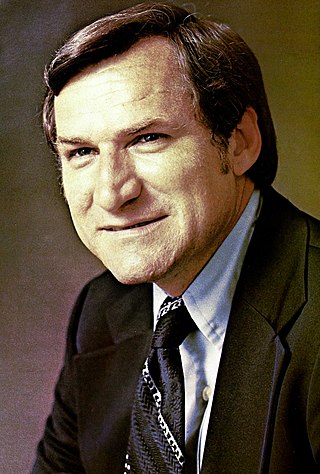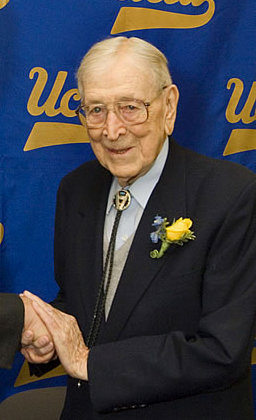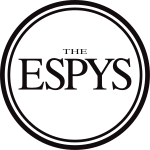
Dean Edwards Smith was an American men's college basketball head coach. Called a "coaching legend" by the Basketball Hall of Fame, he coached for 36 years at the University of North Carolina at Chapel Hill. Smith coached from 1961 to 1997 and retired with 879 victories, which was the NCAA Division I men's basketball record at that time. Smith had the ninth-highest winning percentage of any men's college basketball coach (77.6%). During his tenure as head coach, North Carolina won two national championships and appeared in 11 Final Fours. Smith played college basketball at the University of Kansas, where he won a national championship in 1952 playing for Hall of fame coach Phog Allen.

An ESPY Award is an accolade currently presented by the American broadcast television network ABC except 2020, and previously ESPN, to recognize individual and team athletic achievement and other sports-related performance during the calendar year preceding a given annual ceremony. The first ESPYs were awarded in 1993. Because of the ceremony's rescheduling prior to the 2002 iteration thereof, awards presented in 2002 were for achievement and performances during the seventeen-plus previous months. As the similarly styled Grammy, Emmy, Academy Award, and Tony, the ESPYs are hosted by a contemporary celebrity; the style, though, is lighter, more relaxed and self-referential than many other awards shows, with comedic sketches usually included.

The John R. Wooden Award is an award given annually to the most outstanding men's and women's college basketball players. The program consists of the men's and women's Player of the Year awards, the Legends of Coaching award, and recognizing the All-America Teams.

James Thomas Anthony Valvano, nicknamed Jimmy V, was an American college basketball player, coach, and broadcaster.
The Big East Conference Men's Basketball Player of the Year award is given to the men's basketball player in the Big East Conference voted as the top performer by the conference coaches. It was first awarded at the end of the league's inaugural season of 1979–80.
The Frances Pomeroy Naismith Award was an annual college basketball award in the United States intended to honor players who excelled on the court in spite of their height. The award, named in honor of James Naismith's daughter-in-law, was established for men in 1969 and for women in 1984. The men's award was presented to the nation's most outstanding senior who stands 6 ft 0 in (1.83 m) or shorter, while the women's award was presented to the top senior who is 5 ft 8 in (1.73 m) or shorter. Early in the women's award's history, the cut-off height was 5 ft 6 in (1.68 m). The men's award was selected by a panel from the National Association of Basketball Coaches (NABC), while the women's was selected by the Women's Basketball Coaches Association (WBCA). The award was discontinued following the 2013–14 season.

Maya April Moore is an American social justice advocate and former professional basketball player. Naming her their inaugural Performer of the Year in 2017, Sports Illustrated called Moore the "greatest winner in the history of women's basketball". Moore was selected for the Women's Basketball Hall of Fame in 2024.
The 2005 ESPY Awards were announced from Kodak Theatre on July 13, 2005 and showed during the telecast on ESPN, July 17, 2005. ESPY Award is short for Excellence in Sports Performance Yearly Award.
The Best Male Athlete ESPY Award, known alternatively as the Outstanding Male Athlete ESPY Award, is an annual award honoring the achievements of individual men from the world of sports. It has been presented annually at the ESPY Awards since 1993 to the male voted irrespective of nationality or sport contested, adjudged to be the best athlete in a given calendar year. The Best Male Athlete ESPY Award trophy, designed by sculptor Lawrence Nowlan, is presented to the recipient at an annual ceremony in Los Angeles. Since 2004, the winner has been chosen by online balloting through three to five choices selected by the ESPN Select Nominating Committee. Before that, determination of the winners was made by an panel of experts. Through the 2001 iteration of the ESPY Awards, ceremonies were conducted in February of each year to honor achievements over the previous calendar year; awards presented thereafter are conferred in July and reflect performance from the June previous.

The Best Male College Basketball Player ESPY Award was presented annually between 1993 and 2001 to the male collegiate basketball player determined to be the best in the NCAA in the previous season. The award was discontinued in 2002 when it was absorbed into the overall Best Male College Athlete ESPY Award.
The ESPY Award for Best College Athlete, Men's Sports, known before 2021 as the Best Male College Athlete ESPY Award, is an annual award honoring the achievements of a male individual from the world of collegiate sports. It was first presented as part of the ESPY Awards in 2002, following the subsumption of the Best College Football Player and Best Male College Basketball Player ESPY Awards, each of which had been presented annually between 1993 and 2001, inclusive. The award trophy, designed by sculptor Lawrence Nowlan, is awarded to the sportsman adjudged to be the best in a given calendar year of those contesting collegiate sport in the United States through the National Collegiate Athletic Association (NCAA).
The ESPY Award for Best College Athlete, Women's Sports, known before 2021 as the Best Female College Athlete ESPY Award, is an annual award honoring the achievements of a female individual from the world of collegiate sports. It was first presented as part of the ESPY Awards in 2002, following the subsumption of the Best Female College Basketball Player ESPY Award, which was presented annually between the 1993 and 2001 ceremonies, inclusive. The award trophy, designed by sculptor Lawrence Nowlan, is awarded to the sportswoman adjudged to be the best in a given calendar year of those contesting collegiate sport in the United States through the National Collegiate Athletic Association (NCAA). Since the 2004 awards, the winner has been chosen by online voting through three to five nominees selected by the ESPN Select Nominating Committee. Before that, determination of the winners was made by an panel of experts. Through the 2001 iteration of the ESPY Awards, ceremonies were conducted in February of each year to honor achievements over the previous calendar year; awards presented thereafter are conferred in July and reflect performance from the June previous.
The Best Breakthrough Athlete ESPY Award, known alternatively as the Breakthrough Athlete of the Year ESPY Award, is an annual award honoring the achievements of an individual in the world of sports. It was first awarded as part of the ESPY Awards in 1993. The Best Breakthrough Athlete ESPY Award trophy, created by sculptor Lawrence Nowlan, is awarded to the sportsperson adjudged to have made the greatest breakthrough in a major international individual sport or North American professional team sport. The award is typically given to a sportsperson in his or her rookie season at a given level but may be won by any athlete who in a given year improves his or her performance dramatically or otherwise becomes well-recognized. Since 2004, the winner has been chosen by online voting through choices selected by the ESPN Select Nominating Committee. Before that, determination of the winners was made by an panel of experts. Through the 2001 iteration of the ESPY Awards, ceremonies were conducted in February of each year to honor achievements over the previous calendar year; awards presented thereafter are conferred in July and reflect performance from the June previous.
The Best Game ESPY Award is an annual award honoring the achievements of a team who has performed the best play in the world of sports. It was first awarded as part of the ESPY Awards in 2002. The Best Game ESPY Award trophy, designed by sculptor Lawrence Nowlan, is awarded to the team on the single regular season or playoff game contested professionally under the auspices of one of the four major North American leagues or collegiately under the auspices of the National Collegiate Athletic Association adjudged, in view of its quality, competitiveness, excitement, and significance, to be the best. Since 2004, the winner has been chosen by online voting through choices selected by the ESPN Select Nominating Committee. Before that, determination of the winners was made by an panel of experts. Through the 2001 iteration of the ESPY Awards, ceremonies were conducted in February of each year to honor achievements over the previous calendar year; awards presented thereafter are conferred in July and reflect performance from the June previous.
The Chuck Taylor Most Valuable Player Award was created to honor the most valuable player of the National Association of Intercollegiate Athletics (NAIA) men's basketball national tournaments. Established in 1939 and later named as an homage to the Chuck Taylor All-Stars, an iconic basketball shoe in the early 20th century, it has been awarded every year with the exceptions of 1944 due to World War II and 2020 due to the coronavirus pandemic. Between the 1991–92 and 2019–20 seasons, the NAIA was split into Division I and Division II. Each division subsequently held their own national tournament, with MVPs awarded for them respectively. Starting with the 2020–21 season, the NAIA returned to non-divisional classifications.
The Gatorade Player of the Year awards are given annually to up and coming high school student-athletes in the United States. They are given for boys baseball, boys and girls basketball, boys and girls cross country, boys football, boys and girls soccer, boys and girls track & field, girls softball, and girls volleyball.
The Atlantic 10 Conference Men's Basketball Player of the Year is an award given to the Atlantic 10 Conference's (A–10) most outstanding player. The award was first given following the conference's inaugural 1976–77 season, when the conference was officially known as the Eastern Collegiate Basketball League but popularly known as the Eastern 8. David West of Xavier is the only player to have won the award three times (2001–2003). Four other players have won the award twice. Three players have also won the award in the same season that they were named the Naismith College Player of the Year or received the John R. Wooden Award, the nation's two most prestigious men's college basketball awards: Marcus Camby in 1996, Jameer Nelson in 2004, and Obi Toppin in 2020.
The 1980–81 NCAA Division I men's basketball season began on November 28, 1980, progressed through the regular season and conference tournaments, and concluded with the 1981 NCAA Division I men's basketball tournament championship game on March 30, 1981, at The Spectrum in Philadelphia. The Indiana Hoosiers won their fourth NCAA national championship with a 63–50 victory over the North Carolina Tar Heels.

Andrick Cora Jackson is an American former multi-sport athlete. He played college basketball for Ranger College before transferring to the University of Nevada where he played both basketball and American football. He later played football professionally, including for the Cleveland Browns of the National Football League (NFL). In 2004, he was named the NFL Europe Defensive Player of the Year.

Caitlin Clark is an American college basketball player for the Iowa Hawkeyes of the Big Ten Conference. She is the NCAA Division I all-time leading scorer and is regarded as one of the greatest players in women's college basketball history.







